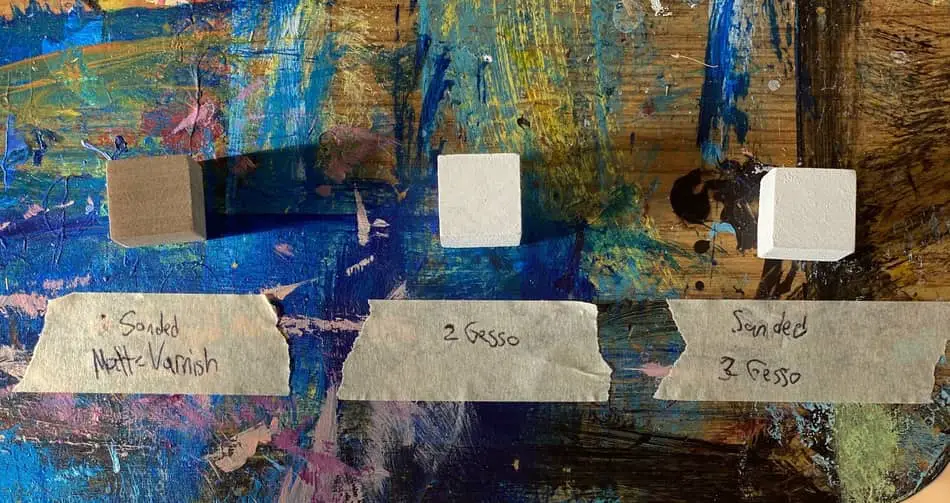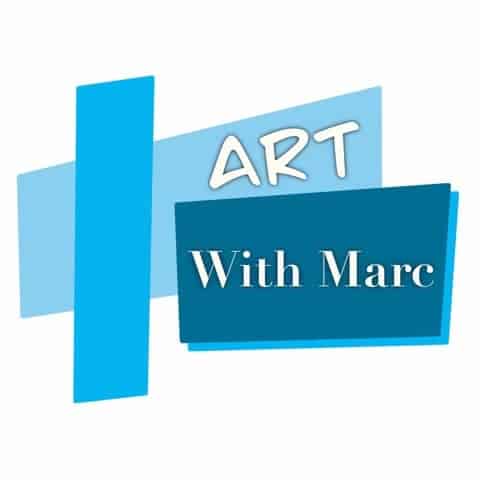
Before you start painting on any piece of wood you need to be sure to properly prep it. Unless of course, you have purchased a pre-prepped panel from an art supply store.
This is an option many artists may pursue as a means to save money while enabling the creation of artwork on a variety of new types of surfaces.
We can simplify prepping wood to paint into two basic steps:
- Sand your wood surface that you would like to paint. Sanding your surface removes excess dirt and impurities allowing for the next step.
- Seal or prime your surface so your wood doesn’t absorb your paint. This will ensure you get clear lines and that your paint dries vibrant.
Now that is an oversimplification of the full process you need to know and the variety of approaches there are to properly prepare the wood you want to paint on.
Maybe you want the pattern of the grain to show through your painting? Perhaps you have a piece of furniture you’d like to paint something on.
Let’s check out some more details on how to do that!
Sanding Your Surface: Why and How?
To begin with, we need to sand our surface down.
No matter the wood surface you want to paint on there is going to be a layer of dirt, dust, and other impurities we will need to remove first.
To sand your wood surface you will want any light grade sandpaper. I’ve seen people using sandpaper of 140 grit all the way up to 220 grit.
When you start your sanding it’s important to sand with the grain. If you sand against the grain it ruins the wood and makes it look all scratched up.
Just apply a moderate amount of weight as you sand it and be sure to sand all the surfaces you are going to apply your sealer to.
Once you complete sanding your surface, use a dry paint brush to dust the surface off. Some even suggest after doing this to wipe it off with a damp rag too to further help pick up and remove more dirt and dust.
If you do the damp rag be sure to let the wood dry completely before you move on to sealing your surface.
Different Ways to Seal Your Surface

Once you have sanded your surface and allowed it to dry completely, now you want to move on to sealing your surface.
There are varying opinions and approaches on how to do this step.
Some people make say to seal it and then prime it others say that a few layers of gesso is all you need. Both are valid approaches to take and can get you quality results.
It is important to note the gesso is a primer and not technically a sealer. That said, you can use multiple layers of gesso to seal your wood surface. It may take a few layers but plenty of artists do it.
When you do it this way be sure to sand between each layer if you want a smooth surface to paint on. You will want at least 2 layers but some people do 4 or even 6 layers.
You likely can use less layers of gesso if you do seal your wood with a more proper wood sealer.
One method of sealing that I saw an artist on YouTube use, CLIVE5ART, was to use PVA glue. He took the PVA glue and mixed it with water in what looked like a one to one ration to thin it down.
Then he applied it on to his wood surface where he wanted to paint.
After he lets it dry he lightly sands it and then does a second layer of his watered down glue.
Another light sanding, then he layers his gesso on next.
Another thing to note is if you want the wood grain to show through there are clear gesso’s and matte gessos you can use to be sure you get some of that wood grain structure in your painting. We will discuss those in more detail below.
Salvador Dali was known for incorporating details of the wood grain into is surreal landscapes. So sometimes letting that wood show through is an awesome technique to embrace!
Other sealants you can use are basically any gloss or varnish that creates a protective seal.
I personally like the more cost effective idea of using PVA glue. Especially if you buy that in bulk it would be far cheaper than using a gloss. I would reserve the more expensive gloss for sealing the painting when you are done.
While they can be used to seal the surface they aren’t the most cost effective option.
Type of Gesso To Use for Priming
Once you have sealed your surface next you will need to prime your surface.
If you opted to do the previous step with gesso then your surface is already ready to go.
Otherwise, now would be the time to add a couple layers of gesso to your wood to create the surface that your paint will adhere to more easily.
When applying your gesso you again want to do a thin layer, perhaps a bit watered down, for the first layer.
Then do a light sanding before applying your next layer.
You don’t always need to sand if you want a more textured look to your painting but if you’re more interested in a smooth surface sanding is a must.
There is a treasure trove of different gesso’s out there to choose from. So many I can’t possibly review all of them here in a concise manner.
I can however go over a few of the brands you may be interested in using for your wood projects! There are some specialty gesso’s that you need to know about!
Something like Sandable Hard Gesso can only be applied to something with rigid support as it will crack when it is flexed. So this is a great gesso to use for your wood projects as its designed specifically for something like wood!
It’s a bit more absorbent than Golden Acrylic Gesso and will sand to a smoother surface than most other Gesso’s.
Another great option for your wood projects is Krylon Gesso. This one is actually is one of the only gesso’s I’ve ever seen to come in an aerosol can.
This is great as it can help to avoid brush strokes which can be a problem sometimes. Especially if your gesso is getting thick! Adding water can often help reduce brush strokes but this is an even better option!
With it able to dry in 30 seconds and the quick application through spray you can cut your prep time down to a fraction of what it normally is when you have to wait for your gesso to dry.
So adding multiple coats is quick and easy. Plus now you won’t have any brushes to clean up either!
Finally, let’s talk about the types of primer that let the wood grain come through.
One option you can go with is the Golden Matte Medium. It says in the product description that it creates a clear ground.
I’ve seen other artists online saying the same thing so I had to look this phrase up. To the best of my understanding this means it creates a clear coat that the paint can ground to.
So if you read a product description that says it can create a clear ground for acrylic paint then that should work too!
Another great option to let the wood show through is Liquitex Acrylic Medium – Clear Gesso. You can tell it will dry clear because it’s in the name!
Winsor & Newton Artist’s Acrylic Gesso also have a clear gesso you can go with too!
Keep in mind that pretty much all types of gesso can be tinted with a bit of acrylic paint as well. Most of them have in their description a recommended ratio of mixing too.
This way you can create your own colored clear coat if you wanted! I sure as heck am going to have to try some of this stuff out myself!

